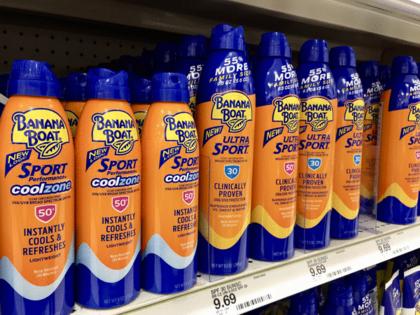Congress sees bipartisan bright spot in sunscreen legislation
Published in Political News
Lawmakers from both sides of the aisle are collaborating on legislation to lower market barriers for new sunscreens, in an effort to bring the United States in line with other countries that have seen advancements in sun protection.
The proposed legislation, introduced separately in the House and Senate, is now being considered as an amendment to a Senate bill that would reauthorize the Over-the-Counter Monograph Drug User Fee Program, also known as OMUFA. It would expand on the The Food and Drug Administration’s authority from a 2020 law directing the agency to consider historical data on the safety of sunscreen active ingredients that have previously been accepted for marketing.
It would also direct the FDA to account for the role that products deemed SPF 15 or higher have in preventing skin cancer, and would require the agency to report its progress in allowing for nonclinical alternatives to animal testing for new sunscreen ingredients.
At a time when Congress has been fiercely divided over other health care issues — including cuts to Medicaid and the Trump administration’s clawback of health research funding — lawmakers are highlighting the collaboration between Democrats and Republicans on the issue.
Over-the-counter sunscreens in the United States must be listed in an OTC monograph, essentially a recipe, that outlines which ingredients are safe to include and how the product must be labeled. For a new sunscreen ingredient to be added to the monograph, it first must go through clinical testing and prove that it’s not harmful to humans. The United States hasn’t cleared a new sunscreen ingredient for the market since 1999.
By contrast, many Asian and European countries, which regulate sunscreens as cosmetic or therapeutic products, have introduced ingredients that allow for a smoother and lighter application.
For example, Europe has cleared four sunscreen filters — bemotrizinol, bisoctrizole, ecamsule, and drometrizole trisiloxane — all of which appear to be more effective than the most common filter in the United States, avobenzone. But the FDA has prevented companies from using those ingredients because they don’t have sufficient safety data to prove that they aren’t harmful to human health.
Path to law
The legislation still has a ways to go. On the House side, it was also introduced as an amendment during the House Energy and Commerce Committee markup of OMUFA in July, but that was withdrawn after Chairman Brett Guthrie, R-Ky., agreed to work on sunscreen reform legislation beyond the markup.
The legislation could get a lifeline in the Senate version of OMUFA, which the Senate Health, Education, Labor and Pensions Committee advanced late last month.
Rep. John Joyce, R-Pa., who sponsored the House version, said in a statement that he was encouraged to see it advance in the other chamber.
“As the only board-certified dermatologist in Congress, I remain committed to working with my colleagues in the House to advance a strong OMUFA package that will streamline the FDA approval process for innovative sunscreen ingredients that will ultimately protect the lives of thousands of Americans each year,” Joyce said.
The bill’s progress also is significant in an environment in which the Trump administration is removing regulations rather than adding them.
Sen. Maggie Hassan, D-N.H., who sponsored the Senate version, said in a video posted on the social media platform X that “There are people in other parts of the world, like Korea, who have much better sunscreen than we do. People like it a lot more, they wear it a lot more … We should be able to get that sunscreen too.”
Dermatology and skin cancer groups have for years said that the United States’ regulatory pathway for sunscreen prevents innovation and has allowed other countries to surpass the U.S. market with new products.
Melanie Benesh, vice president for government affairs at the Environmental Working Group, said in an interview that under the Food, Drug and Cosmetic Act, sunscreen is considered a drug because it is used for the prevention of skin cancer.
But some ingredients in sunscreens don’t just sit on top of the skin, but can make their way into the bloodstream, and the FDA needs to determine that they’re not harmful before it can clear an ingredient for use, Benesh said.
“Really the FDA has no choice but to treat them as drugs under our laws,” she said. “And that’s a good thing, because these are active ingredients.”
Dana Deighton, the director of communications and engagement at the Melanoma Research Alliance, which supports the bill, said in an interview that the legislation would in effect ease the barrier to entry for new ingredients.
Deighton noted that one in five people will get skin cancer before the age of 70 and there’s been a recent spike in young women getting skin cancer from using tanning beds or not using sunscreen outside.
She said the legislation could create the potential to make updated formulations available to populations that may not always wear sunscreen, like construction workers or members of the military who spend their days working outside
“There are examples of safe, effective, and well-received sunscreen formulations available in other parts of the world, and it would be great if we could have the breadth of options to suit different needs here in the U.S., too,” Deighton said. “Everybody wants to be able to enjoy the outdoors more safely.”
But Benesh said the changes proposed fall short of giving the FDA substantial new authority to require manufacturers to produce more safety data about their products.
“I’m not sure that this bill really moves us forward, because it’s not compelling the sunscreen industry to produce the kind of information that the FDA needs to determine whether or not these ingredients are safe,” Benesh said.
Giving the FDA authority to require sunscreen companies to produce the data it needs, or the authority to find the information itself, would be more impactful, she said. The OMUFA program’s user fees could cover some of the cost, she added.
“It would be great if the FDA could use some of these user fees to generate some of the data on their own, to fill in these data gaps, and hopefully then be able to bring some of these newer-generation filter funds to the market,” she said.
_____
©2025 CQ-Roll Call, Inc., All Rights Reserved. Visit cqrollcall.com. Distributed by Tribune Content Agency, LLC.
























































Comments